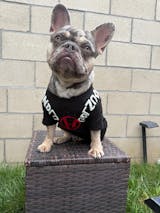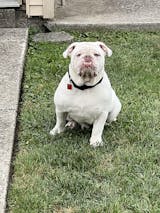How to Protect Your Dog's Paws in the Winter
Winter wonderlands might be an exciting time for us, but they bring unique challenges for our furry friends. As the snow falls and the temperatures drop, our dogs face potential hazards to their paw pads from snow, ice, and salt. Understanding these risks is crucial for every pet parent. Here's a rundown of the common issues and some tips on how to ensure your dog's paws stay happy and healthy throughout the chilly winter season!

Common Paw Issues During the Winter:
Cracked Pads: Cold weather can lead to dry, cracked paw pads in dogs. The combination of icy surfaces and low humidity can strip the natural moisture from their paws, leading to painful fissures and splits. Harsh chemicals like salt used for de-icing can further aggravate this issue, making their paw pads more vulnerable to cracking.
Ice Build-Up: During winter, dogs' paw pads can accumulate ice between their toes while walking on snowy or icy surfaces. This ice build-up can cause discomfort, leading to irritation and small cuts. Additionally, the pressure from the ice between their pads can create discomfort and make it harder for them to walk comfortably.
Salt and Chemicals: Salt and de-icing chemicals used on sidewalks and roads can be abrasive and irritating to a dog's paw pads during winter. Contact with these substances can cause dryness, cracking, and chemical burns on their sensitive paw pads. Dogs may experience discomfort or even lick their paws excessively due to the irritation caused by these substances.
Frostbite: Dogs are susceptible to frostbite on their exposed skin, including their paw pads, when exposed to extreme cold for prolonged periods. The low temperatures can constrict blood vessels, reducing blood flow to the extremities. As a result, this can further lead to tissue damage. Paw pads can become pale, cold to the touch, and eventually develop blisters or blackened skin if frostbite occurs.
Tips to Protect Your Dog's Paws:
- Invest in Paw Protection: Consider dog booties to shield paws from harsh weather. Not all dogs take to booties immediately, so be patient with the introduction.
- Trim Paw Hair: Trimming the hair between a dog's paw pads can prevent snow and ice from accumulating and forming uncomfortable ice balls around your dogs’ toes. You reduce the risk of potential irritation and discomfort caused by packed snow by keeping the fur neatly trimmed. Additionally, shorter hair between the pads can minimize moisture retention, helping to prevent frostbite and maintain better paw hygiene in cold weather.
- Use Pet-Safe Ice Melt: Pet-safe ice melt products are formulated to be less harsh and less harmful to a dog's paw pads compared to traditional ice melts. These safer alternatives help prevent chemical burns and irritation on the sensitive skin of the paw pads. Choosing pet-safe options minimizes the risk of discomfort or injury when your dog walks on treated surfaces during winter.
- Wipe or Wash Paws After Walks: Wiping or washing your dog's paws after a walk in the winter helps remove salt, ice, and debris from your dog’s paws. As a result, it helps in preventing potential irritation and discomfort. Squishface Wrinkle Wipes offer a convenient solution, making it easy to clean their paws between daily outings. These wipes are not only convenient but also effective in combating yeast, fungus, and bacteria that might accumulate on their paw pads in cold and damp conditions.
- Moisturize Dry Paw Pads: Wrinkly and brachycephalic breeds are more likely to experience paw problems during the winter. Their compact paws and skin folds can trap moisture, salt, and debris, leading to irritation, dryness, and even infections. To help protect those sensitive toes, apply Squishface Toe Paste on a daily basis not only year-round, but especially throughout the colder months. This fast-drying, paw-safe dog toe paste helps absorb excess moisture, soothe irritation, and create a gentle barrier that keeps bacteria and yeast at bay.
- Limit Time Outdoors in Extreme Cold: Limiting a dog's time outdoors in extreme cold temperatures helps prevent prolonged exposure to harsh weather conditions that can damage their paw pads. Excessive cold can lead to frostbite and discomfort in their sensitive paws. By minimizing their exposure, you are helping to reduce the risk of frostbite and other cold-related injuries your pup may experience.
- Provide Warm and Dry Resting Areas: By providing warm and dry resting areas for your dog, it allows your dog to have time to recover from exposure to cold and moisture. Cold and damp surfaces can further contribute to your pup’s discomfort, and can contribute to potential damage to their paws pads. A cozy indoor spot ensures that your pup can rest and warm up in-between these outings.
- Check for Signs of Discomfort: Regularly checking for signs, such as limping, excessive licking, or chewing of their paws, allows for early detection of potential issues in your dog's paw pads. Promptly addressing any discomfort helps prevent further damage or irritation to their sensitive paw pads caused by cold weather or other environmental factors. Early intervention ensures proper care and prevents minor issues from escalating into something more serious.
The Bottom Line:
As we navigate the winter wonderland with our furry friends, remember that a little extra care goes a long way in keeping those paw prints happy and healthy. With the convenience of Squishface Wrinkle Wipes, you can swiftly clean away any winter remnants all while effectively battling against yeast, fungus, and bacteria.
Whether it's using pet-safe ice melt, investing in dog boots, or utilizing Squishface Wrinkle Paste to provide that extra layer of protection and hydration between walks, caring for your dog's paws is crucial to their daily care. By incorporating these tips and products into your winter routine, you can ensure your pup's paws are well-protected, allowing for endless snowy adventures and cozy snuggles indoors.
Be sure to follow us on TikTok, Instagram, Facebook, Pinterest, YouTube, and visit our blog weekly for more tips on caring for your precious pup, and the latest on all things Squishface!










